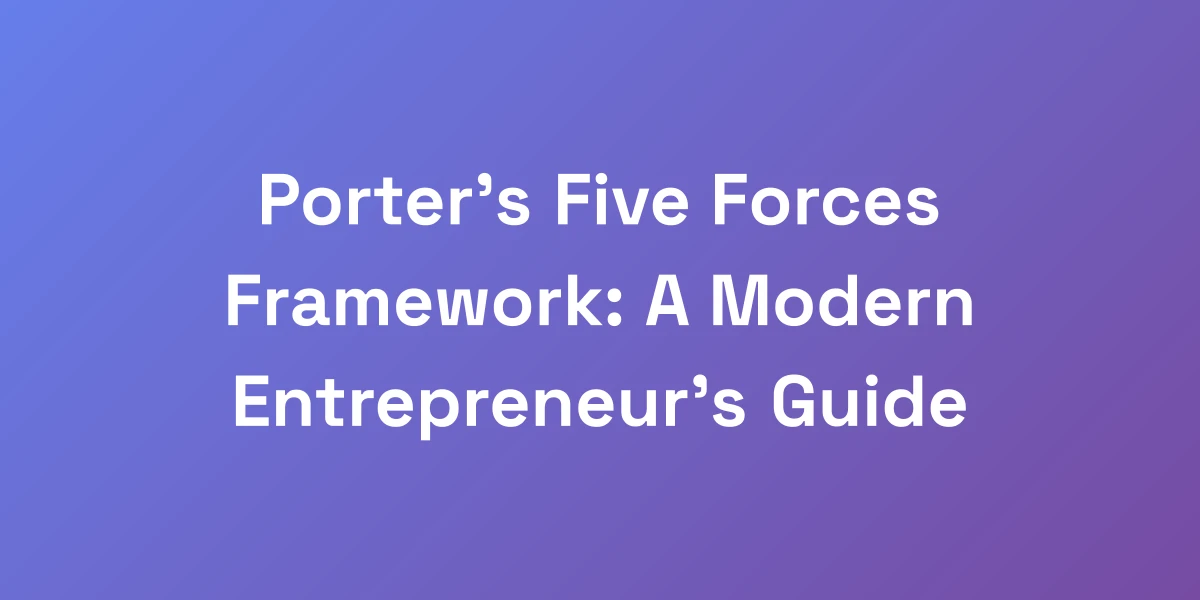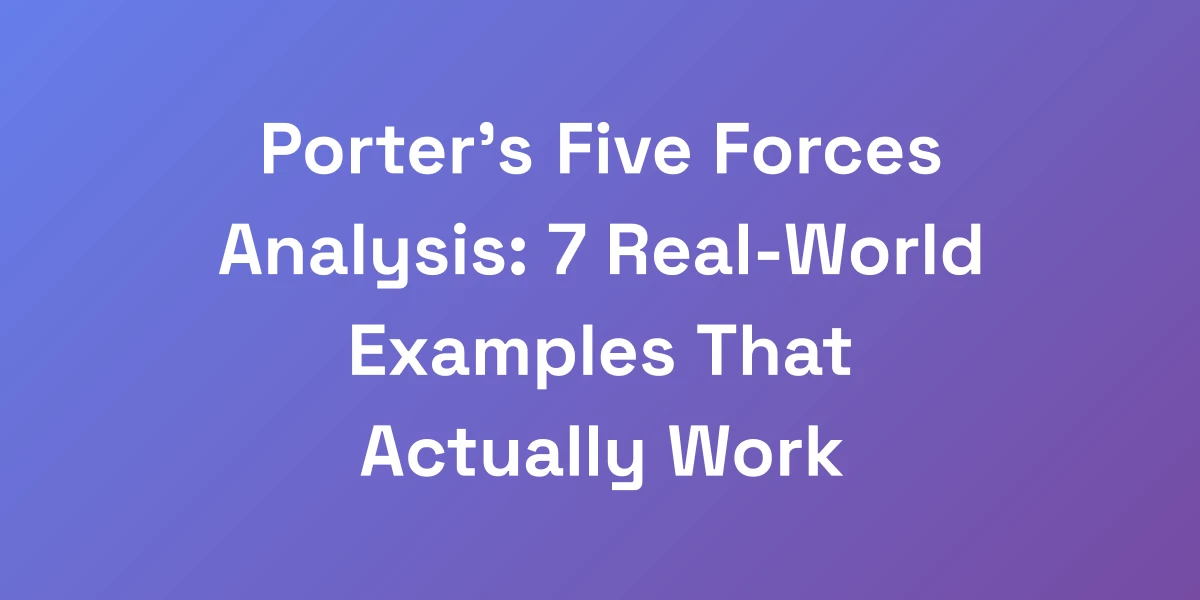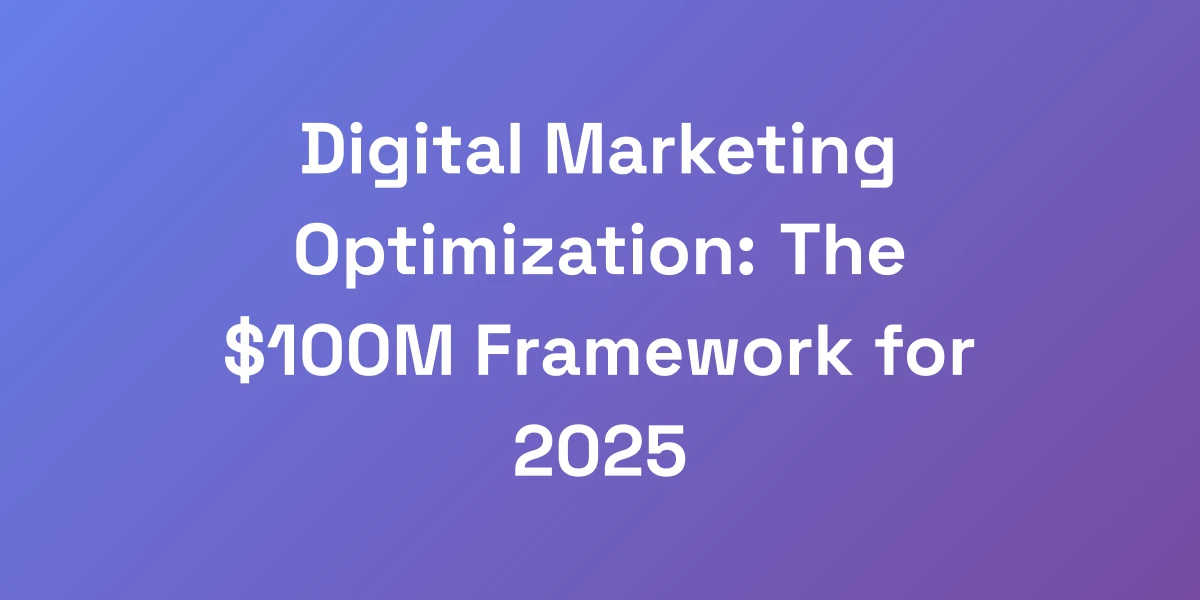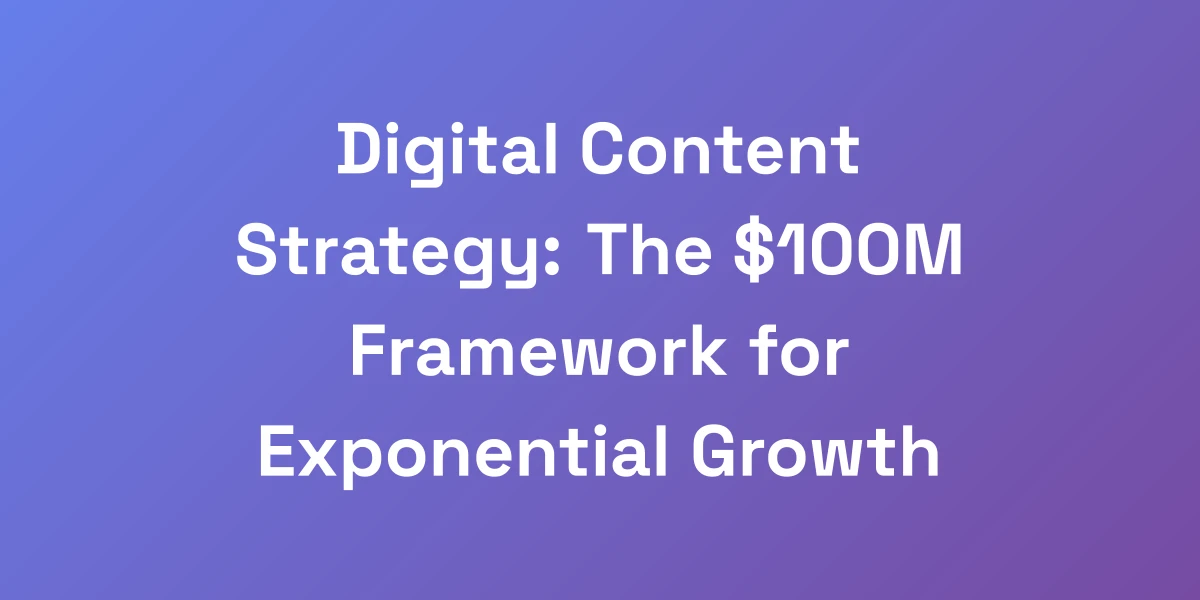
Porter’s Five Forces: A Modern Framework for Digital Disruption
Mar 25, 2025 | By [email protected]
Porter’s Five Forces: A Modern Framework for Digital Disruption
In a world where digital transformation is reshaping every corner of the economy, understanding the competitive landscape has never been more critical. We stand at the crossroads of traditional strategy and modern disruption, where the rules have changed, but the game remains the same. Porter’s Five Forces framework offers a lens through which we can dissect the complexities of today’s markets.
But how does a model conceived in 1979 hold up against the rapid advancements of the digital age? The challenges are multifaceted: new entrants emerge overnight, customer expectations evolve with AI-driven personalization, and suppliers wield unprecedented influence through digital ecosystems. What if we could adapt this classic framework to not only survive but thrive amidst digital upheaval?
Join us as we delve deep into the evolution of Porter’s Five Forces, exploring its relevance and application in an era defined by digital disruption. Whether you’re a seasoned strategist or navigating the digital waters for the first time, this comprehensive guide will illuminate the path forward.
Understanding the Evolution of Porter’s Five Forces in Today’s Economy
In an age where traditional business models are constantly being challenged, Porter’s Five Forces framework remains surprisingly relevant. Yet, its application has evolved dramatically since Michael Porter first introduced it in 1979. The framework’s enduring power lies not in its rigidity, but in its adaptability to modern market dynamics.
What’s fascinating is how digital transformation has actually amplified the framework’s importance, making it an even more crucial tool for understanding competitive landscapes in ways Porter himself might never have imagined.
The Origin Story: From Harvard to Global Strategy Standard
Porter’s journey began at Harvard Business School, where he sought to provide businesses with a structured approach to analyzing competition. His Five Forces—Threat of New Entrants, Bargaining Power of Buyers, Bargaining Power of Suppliers, Threat of Substitutes, and Competitive Rivalry—quickly became a staple in strategic planning.
But why did this framework resonate so deeply? It was the simplicity yet profundity of identifying the underlying forces that shape every industry. As businesses grappled with increasing globalization, Porter’s model offered a clear method to dissect and understand the competitive pressures they faced.
Why Traditional Frameworks Still Matter in the Digital Age
Even as technology transforms industries, traditional frameworks like Porter’s Five Forces provide a foundational understanding of market dynamics. They offer a structured way to think about competition, customer behavior, and supplier relationships—elements that remain vital despite digital shifts.
Consider the digital agency industry: thanks to low barriers to entry, new competitors can emerge swiftly. Yet, Porter’s Five Forces model helps us analyze how these new entrants impact existing players, the power dynamics at play, and the overall market attractiveness.
The Transformation of Competition in Modern Markets
Competition today is not just about who offers the best product or service. It’s about who leverages digital tools and data analytics to gain a strategic edge. AI-driven platforms can personalize experiences, reduce switching costs, and create new forms of competitive pressure.
We see this in the way startups use AI to disrupt traditional industries, offering more agile and customer-centric solutions. The competitive landscape is no longer static; it’s a dynamic interplay of technology, innovation, and strategic maneuvering.
Key Updates to Porter’s Original Framework
To stay relevant, we need to augment Porter’s Five Forces with considerations for digital factors. This means integrating technology advancements, network effects, and data-driven strategies into each of the five forces.
For instance, the Threat of New Entrants now includes the speed at which a digital business can scale, thanks to cloud computing and AI. Similarly, the Bargaining Power of Buyers is heightened by access to real-time data and personalized experiences.
Digital Disruption’s Impact on Competitive Analysis
Digital disruption doesn’t just modify existing competitive forces—it often redefines them. The rise of AI-powered platforms has lowered switching costs, increased buyer power, and intensified rivalry among competitors. Understanding these shifts is crucial for any modern competitive analysis.
Businesses must now account for digital ecosystems and the interconnectedness of modern markets. This requires a more nuanced application of Porter’s framework, one that embraces the fluidity and speed of digital transformation.
Breaking Down the Five Forces in the Modern Context
The beauty of Porter’s framework lies in its elegant simplicity masking profound strategic insights. Each force represents a fundamental truth about market dynamics that transcends time and technology. When we examine these forces through a contemporary lens, we see how digital transformation has created new competitive pressures while amplifying traditional ones.
The key is understanding how these forces have evolved without losing their essential character, allowing us to apply them more effectively to today’s business challenges.
Threat of New Entrants in a Zero-Barrier World
Today, the barriers to entry in many digital markets are startlingly low. Whether it’s launching an e-commerce platform or a digital marketing agency, the initial investment is often minimal compared to traditional industries.
However, this influx of new players intensifies competition, forcing existing businesses to innovate continually. For example:
- Digital Agencies: With near-zero barriers to entry, countless startups have flooded the market, each vying for a slice of the digital marketing pie.
- Software Startups: Cloud services and open-source platforms have democratized software development, allowing new entrants to launch sophisticated applications with minimal overhead.
Actionable Tip: To mitigate the threat of new entrants, focus on building brand loyalty, developing proprietary technologies, and creating network effects that make it difficult for newcomers to compete on the same level.
Customer Power in the Age of Perfect Information
In the digital era, customers are more informed and empowered than ever. Access to real-time price comparisons, product reviews, and personalized experiences has shifted the power balance significantly.
AI-powered platforms have reduced switching costs by providing seamless and tailored experiences, increasing buyer power and competition among businesses.
- E-Commerce Shoppers: Customers can effortlessly compare products across multiple platforms, demanding higher quality and better prices.
- Service Consumers: Personalized recommendations and instant feedback loops mean customers expect immediate and relevant responses.
Actionable Tip: Enhance customer engagement through personalization, invest in data analytics to understand customer behavior, and foster loyalty programs to retain your customer base.
Supplier Dynamics in Digital Ecosystems
Digital ecosystems have transformed supplier relationships, often amplifying supplier power. In sectors like technology, few suppliers control critical components, such as high-end semiconductors. Utilizing Guaranteed SEO services can influence the bargaining power of suppliers by enhancing your firm’s market presence and reducing dependency on individual suppliers.
For instance, giants like TSMC and Samsung exert significant influence over the semiconductor industry, dictating prices and availability. Similarly, in digital platforms, suppliers can leverage network effects to strengthen their bargaining positions.
- Tech Suppliers: Limited suppliers of crucial hardware can control the market dynamics, affecting downstream businesses.
- Software Vendors: Providers of essential digital tools can dictate terms, influencing the competitive landscape.
Actionable Tip: Diversify your supplier base, invest in supplier relationships, and explore vertical integration to reduce dependence on powerful suppliers.
Substitutes and the Innovation Economy
The digital age fosters a culture of continuous innovation, leading to a surge in potential substitutes. From streaming services replacing traditional cable TV to fintech solutions displacing traditional banking, the range of substitutes has expanded dramatically.
- Streaming vs. Cable: Platforms like Netflix and Disney+ have become formidable substitutes for traditional cable television, offering on-demand content that caters to diverse tastes.
- Fintech vs. Traditional Banking: Digital banking solutions provide alternatives to conventional financial services, emphasizing convenience and accessibility.
Actionable Tip: Stay ahead by fostering a culture of innovation, continually exploring new technologies, and adapting your offerings to meet evolving customer needs.
Competitive Rivalry in Hyperconnected Markets
Competition in today’s markets is hyperconnected, with businesses and consumers interacting on multiple digital platforms simultaneously. This interconnectedness intensifies rivalry, as competitors can monitor and react to each other’s moves in real time.
- Real-Time Competition: Social media and online review platforms enable customers to instantly share feedback, influencing public perception and competitive dynamics.
- Data-Driven Strategies: Access to vast amounts of data allows competitors to analyze and strategize with unprecedented precision.
Actionable Tip: Leverage data analytics to anticipate competitor moves, engage in real-time marketing, and maintain agile operations to respond swiftly to market changes.
The Network Effect’s Impact on Traditional Forces
Network effects have become a pivotal factor in modern competitive analysis. When the value of a product or service increases with the number of users, it can create a self-reinforcing cycle that strengthens a company’s market position.
- Social Networks: Platforms like Facebook and LinkedIn become more valuable as more users join, attracting even more participants.
- Marketplaces: E-commerce giants like Amazon benefit from a vast network of sellers and buyers, enhancing their competitive edge.
Actionable Tip: Focus on building and enhancing network effects by encouraging user engagement, fostering community growth, and creating value-added features that benefit all participants.
Practical Application: Conducting a Modern Five Forces Analysis
The real value of Porter’s framework emerges in its practical application to real-world scenarios. Modern analysis requires a blend of traditional strategic thinking and contemporary market understanding. What’s particularly interesting is how digital tools and data analytics have transformed our ability to measure and quantify these forces.
The key is maintaining the framework’s strategic depth while leveraging modern analytical capabilities to gain deeper insights into competitive positioning.
Step-by-Step Analysis Framework
Conducting a modern Five Forces analysis involves a systematic approach:
- Define the Industry: Clearly outline the boundaries of the market you’re analyzing.
- Analyze Each Force: Examine the Threat of New Entrants, Bargaining Power of Buyers, Bargaining Power of Suppliers, Threat of Substitutes, and Competitive Rivalry in the context of the digital landscape.
- Gather Data: Utilize digital tools to collect relevant data, including market trends, customer behavior, and competitor strategies.
- Evaluate the Impact: Assess how each force affects your business’s ability to compete and sustain profitability.
- Develop Strategies: Formulate strategies to mitigate threats and leverage opportunities identified through the analysis.
Actionable Tip: Use data visualization tools to map out the Five Forces, making complex data more digestible and actionable for strategic decision-making.
Digital Tools for Force Measurement
Modern digital tools have revolutionized how we measure and analyze the Five Forces. From AI-driven analytics to comprehensive market intelligence platforms, technology provides the means to gather and interpret vast amounts of data efficiently. For instance, devices like the JBL Link View can enhance productivity through smart integration.
- AI Analytics: Tools like Tableau and Power BI leverage AI to uncover patterns and insights from large datasets, enhancing your understanding of market dynamics.
- Competitive Intelligence Platforms: Platforms such as Crayon and SimilarWeb provide real-time data on competitor activities, market trends, and customer sentiment.
- Customer Relationship Management (CRM) Systems: CRMs like Salesforce and HubSpot offer valuable data on customer interactions and preferences, informing buyer power and substitution threats.
Actionable Tip: Integrate AI-driven analytics into your Five Forces analysis to uncover deeper insights and anticipate market shifts before they become apparent to competitors.
Data-Driven Competitive Analysis
Incorporating data-driven approaches into your competitive analysis allows for a more accurate and dynamic understanding of the market. By leveraging big data and real-time analytics, businesses can make informed strategic decisions that are both timely and effective.
- Predictive Analytics: Use predictive models to forecast market trends and competitor behavior, enabling proactive strategy adjustments.
- Customer Insights: Analyze customer data to identify preferences, pain points, and loyalty drivers, enhancing your ability to respond to buyer power dynamics.
Actionable Tip: Implement predictive analytics to anticipate future market conditions and adjust your strategies accordingly, staying ahead of the competition.
Industry-Specific Adaptations
While Porter’s Five Forces provide a universal framework, adaptations may be necessary to account for industry-specific dynamics, especially in digitally driven sectors. For example, the tech industry may focus more on innovation speed, whereas service-based industries might prioritize customer relationships. If you’re in a specific locale like Miami, working with a Miami SEO company can provide tailored strategies aligning with local market dynamics. Additionally, e-commerce platforms like Etsy require a specialized approach to Porter’s Five Forces. Implementing effective Etsy search engine optimization can help businesses better position themselves against competitors.
- Tech Industry: Focus on innovation speed and the impact of open-source platforms on supplier power.
- E-Commerce: Emphasize logistics efficiency and the role of customer reviews in buyer power.
- Financial Services: Consider the influence of regulatory changes and fintech innovations on competitive rivalry and substitution threats.
Actionable Tip: Tailor your Five Forces analysis to reflect the unique aspects of your industry, ensuring that all relevant digital factors are considered.
Common Analysis Pitfalls to Avoid
Even the most seasoned strategists can fall prey to common pitfalls when conducting a Five Forces analysis:
- Overlooking Digital Factors: Failing to account for digital transformation can lead to an incomplete analysis.
- Ignoring Interdependencies: Understanding how the forces interact with each other is crucial for a comprehensive view.
- Static Analysis: Markets evolve rapidly; a static analysis may quickly become outdated.
Actionable Tip: Regularly update your Five Forces analysis to reflect the latest market developments and ensure that digital disruptions are appropriately addressed.
Integration with Other Strategic Tools
To gain a holistic view of your competitive environment, integrate Porter’s Five Forces with other strategic frameworks such as SWOT analysis, PESTEL analysis, and the VRIO framework. Additionally, incorporating content pillars can provide further strategic depth.
- SWOT Analysis: Identifies internal strengths and weaknesses alongside external opportunities and threats.
- PESTEL Analysis: Explores the broader macro-environmental factors that impact your industry.
- VRIO Framework: Assesses the internal capabilities of your business to sustain competitive advantage.
Actionable Tip: Create a strategic toolkit that combines multiple frameworks, allowing for a more nuanced and comprehensive analysis of your business environment.
Case Studies: Five Forces in Action
Nothing illustrates the power of Porter’s framework better than seeing it applied to real-world situations. Modern case studies reveal how companies navigate complex competitive landscapes using this timeless tool. What’s particularly fascinating is how different industries show varying patterns of force intensity and interaction.
These practical examples demonstrate both the framework’s flexibility and its continued relevance in solving contemporary business challenges.
Tech Industry Disruption Analysis
The tech industry is a prime example of how digital transformation can intensify all five forces. Consider the rise of AI-driven platforms:
- New Entrants: Startups with innovative AI solutions can disrupt established players, leveraging low barriers to entry.
- Buyer Power: Consumers demand personalized experiences, pushing companies to continuously innovate.
- Supplier Power: Limited access to advanced AI technologies can give suppliers significant leverage.
- Substitutes: Rapid advancements in technology create constant threats of obsolescence.
- Rivalry: Intense competition drives relentless innovation and strategic maneuvering.
Actionable Tip: In the tech sector, prioritize agility and continuous innovation to stay ahead of both new entrants and existing competitors.
E-commerce Platform Competition
E-commerce platforms like Amazon and Shopify illustrate how network effects and supplier dynamics shape competitive rivalry:
- Network Effects: The more sellers and buyers join the platform, the more valuable it becomes, creating a virtuous cycle that strengthens market position.
- Supplier Bargaining Power: A vast number of suppliers can dilute individual bargaining power, but exclusive partnerships can shift this balance.
- Buyer Power: Easy access to multiple platforms enhances buyer power, demanding better services and competitive pricing.
Actionable Tip: Leverage network effects by fostering a robust community of users and creating value-added services that enhance platform attractiveness.
Traditional Industry Digital Transformation
Consider the banking sector’s digital transformation:
- New Entrants: Fintech startups are rapidly entering the market, offering innovative digital services that challenge traditional banks.
- Buyer Power: Customers now have access to a myriad of digital banking options, increasing their ability to switch providers with ease.
- Supplier Power: Technology providers play a crucial role, and their influence is magnified in digital ecosystems.
- Substitutes: Digital wallets and blockchain technologies present significant substitution threats to traditional banking services.
- Rivalry: The competition is fierce, with both traditional banks and fintech firms striving to capture market share through innovation and superior customer experiences.
Actionable Tip: Embrace digital transformation by investing in cutting-edge technologies and fostering strategic partnerships to enhance your competitive position.
Startup Market Entry Strategy
Startups can utilize Porter’s Five Forces to craft effective market entry strategies:
- Identify Niche Opportunities: Analyze the forces to find underserved segments or gaps in the market.
- Leverage Technology: Use digital tools to minimize barriers to entry and scale rapidly.
- Build Strategic Alliances: Form partnerships with key suppliers or platforms to strengthen your market position.
Actionable Tip: Conduct a thorough Five Forces analysis to identify strategic opportunities and develop a market entry plan that addresses each competitive force effectively.
Global Market Expansion Examples
When expanding globally, companies must reassess Porter’s Five Forces in each new market:
- Local Competition: Understand the intensity of rivalry and identify key local players.
- Supplier Networks: Assess the reliability and bargaining power of local suppliers.
- Regulatory Environment: Evaluate how local regulations impact barriers to entry and overall market dynamics.
Actionable Tip: Adapt your Five Forces analysis to account for regional variations, ensuring that your global expansion strategy is tailored to each market’s unique competitive landscape.
Cross-Industry Comparison Insights
Comparing different industries through the lens of Porter’s Five Forces can reveal unique competitive dynamics and strategic insights:
- Tech vs. Manufacturing: Tech industries often face higher threat of new entrants and substitutes, while manufacturing may contend more with supplier power and competitive rivalry.
- E-commerce vs. Retail: E-commerce benefits from lower barriers to entry and network effects, whereas traditional retail faces higher fixed costs and different competitive pressures.
Actionable Tip: Use cross-industry comparisons to uncover innovative strategies and practices that can be adapted to your own industry, enhancing your competitive advantage.
Future-Proofing Your Five Forces Analysis
As we look toward the future, the evolution of Porter’s framework continues. Emerging technologies and changing market dynamics require us to think differently about how we apply these fundamental principles.
The challenge lies in maintaining the framework’s core insights while adapting to new competitive realities. The key is developing a dynamic approach that can evolve with changing market conditions while retaining the strategic clarity that makes the framework so valuable.
Emerging Technology Impacts
Technologies like AI, blockchain, and the Internet of Things (IoT) are reshaping competitive dynamics across industries:
- AI and Automation: Enhance operational efficiency and create new differentiation opportunities, altering the threat of substitutes and competitive rivalry.
- Blockchain: Introduces new forms of supplier relationships and can disrupt traditional value chains.
- IoT: Connects devices and systems, creating new customer experiences and increasing the complexity of competitor analysis.
Actionable Tip: Stay abreast of emerging technologies and assess their potential impact on each of the Five Forces, ensuring that your analysis remains current and forward-thinking.
Sustainability and ESG Considerations
Environmental, Social, and Governance (ESG) factors are becoming increasingly important in strategic planning:
- Regulatory Pressures: Governments worldwide are enforcing stricter sustainability regulations, affecting barriers to entry and supplier power.
- Consumer Preferences: A growing number of consumers prefer sustainable and ethically produced products, influencing buyer power and threat of substitutes.
- Investor Expectations: Investors are prioritizing companies with strong ESG practices, impacting competitive rivalry and overall market positioning.
Actionable Tip: Integrate ESG factors into your Five Forces analysis to identify new opportunities and mitigate potential risks associated with sustainability trends.
Global Market Integration Effects
Globalization continues to influence competitive forces, with cross-border interactions shaping market dynamics:
- Increased Competition: Global market access can elevate competitive rivalry as companies compete on an international scale.
- Supplier Networks: Global supply chains can enhance supplier power if key suppliers are concentrated in certain regions.
- Substitution Threats: International substitutes can challenge local businesses, especially in tech and consumer goods.
Actionable Tip: Conduct a multi-regional Five Forces analysis to understand the unique competitive dynamics of each market you operate in or plan to enter.
Predictive Analysis Techniques
Incorporating predictive analytics into your Five Forces analysis can provide foresight into future market conditions:
- Trend Forecasting: Use historical data and machine learning models to predict industry trends and competitor movements.
- Scenario Planning: Develop multiple future scenarios based on different force intensities to prepare strategic responses.
- Risk Assessment: Identify potential risks associated with each force and develop mitigation strategies.
Actionable Tip: Implement predictive analytics tools to enhance your Five Forces analysis, providing a more proactive and anticipatory strategic approach.
Adaptive Strategy Development
Developing adaptive strategies ensures that your business can respond effectively to changes in the competitive landscape:
- Flexibility: Design strategies that are flexible and can be adjusted as market conditions evolve.
- Continuous Monitoring: Regularly revisit your Five Forces analysis to stay informed about shifts in the market.
- Agile Decision-Making: Foster an organizational culture that supports quick and informed decision-making.
Actionable Tip: Create a strategic roadmap that incorporates regular assessments of the Five Forces, allowing your business to pivot and adapt as necessary.
Long-term Strategic Planning
Long-term strategic planning requires a forward-looking approach, considering how the Five Forces may evolve over time:
- Future Trends: Anticipate technological advancements and market shifts that could influence competitive dynamics.
- Sustainability: Incorporate long-term sustainability goals into your strategic planning to ensure enduring competitive advantage.
- Innovation Pipeline: Maintain a robust pipeline of innovations to stay ahead of substitutes and new entrants.
Actionable Tip: Develop a long-term strategic plan that integrates your Five Forces analysis with projections for future market developments, ensuring sustained competitiveness.
Conclusion
As we navigate the complexities of a digitally disrupted economy, Porter’s Five Forces remain an indispensable tool for strategic analysis. Their adaptability to modern market dynamics, fueled by technological advancements and shifting consumer behaviors, underscores their enduring relevance.
We’ve explored how each force interacts with digital transformation, offering actionable insights and practical strategies to harness these forces effectively. From understanding the impact of AI on competitive rivalry to leveraging network effects for sustained advantage, integrating Porter’s framework with contemporary tools and perspectives equips us to thrive in an ever-evolving landscape.
Are you ready to apply these insights to your business strategy? Embrace the dynamic approach to Porter’s Five Forces, and let it guide you through the challenges and opportunities of the digital age.
Share your thoughts and experiences with implementing Porter’s Five Forces in the comments below. How has it helped you navigate digital disruption?








